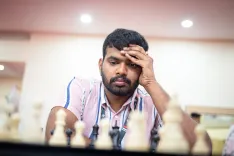Should Jadeja Bowl Longer Spells and How Can India Rotate Pacers for Wickets?

Synopsis
Key Takeaways
- Patience is crucial for the Indian bowlers.
- Smart rotations of bowlers can lead to breakthroughs.
- Proactive field placements are essential.
- Jadeja's long spells could be beneficial.
- A couple of early wickets can change game momentum.
Leeds, June 24 (NationPress) Former coach of India, Ravi Shastri, has emphasized the importance of patience, strategic bowling rotations, and aggressive field placements after India ended the final morning of the first Test against England at Headingley without taking any wickets.
Shastri remarked that India performed better than the previous day but must maintain focus and clarity in their strategy as Ben Duckett and Zak Crawley successfully navigated the session, leading England to 117/0 in pursuit of 371 runs.
Shastri also advised Indian captain Shubman Gill to adopt decisive field placements and exhibit a proactive mindset. "India bowled better than yesterday, but they need to be patient," he stated during a lunch break interview with Sky Sports.
He noted, "The ball did not seam as much as India expected, and it lacked adequate swing, although the bounce was inconsistent," as England reached 117 without loss at lunch, chasing a historic target of 371 runs.
Shastri recommended a reevaluation of the bowling strategy, suggesting, "I would prefer to see Jadeja bowl for extended periods with the three seamers rotating from the Kirkstall Lane End."
He also criticized India's somewhat reactive field placements, stating, "Gill followed the ball with his fields at times when clarity of intention was necessary, indicating a desire to win with catching fielders present."
With wickets being India's only path to victory, Shastri highlighted the game-changing potential of taking a couple of wickets. "Once you achieve that, the game can dramatically shift, placing pressure back on the opposition."
Despite the frustration on the field, Duckett (64)* and Crawley (42)* advanced their overnight partnership to record their fourth-century partnership. They also became the first English opening duo since Alastair Cook and Andrew Strauss to amass over 2,000 runs together in Test cricket.
The Indian bowlers, particularly Jasprit Bumrah and Mohammed Siraj, delivered impressive performances in the overcast conditions under the floodlights, yet they lacked the finishing touch. Duckett displayed fluency, reaching his half-century in just 66 balls, balancing caution with stylish cuts and pulls.
Crawley, while less flamboyant, showed resilience, surviving two near misses – an lbw review from Siraj and a dropped return catch from Bumrah, which represented India's best chance in that session.
While rain was predicted, the weather remained stable, allowing the match to proceed without interruptions. As lunch was called, the Test remained finely poised, with England needing 254 more runs in 66 overs, while India sought that elusive first wicket.







